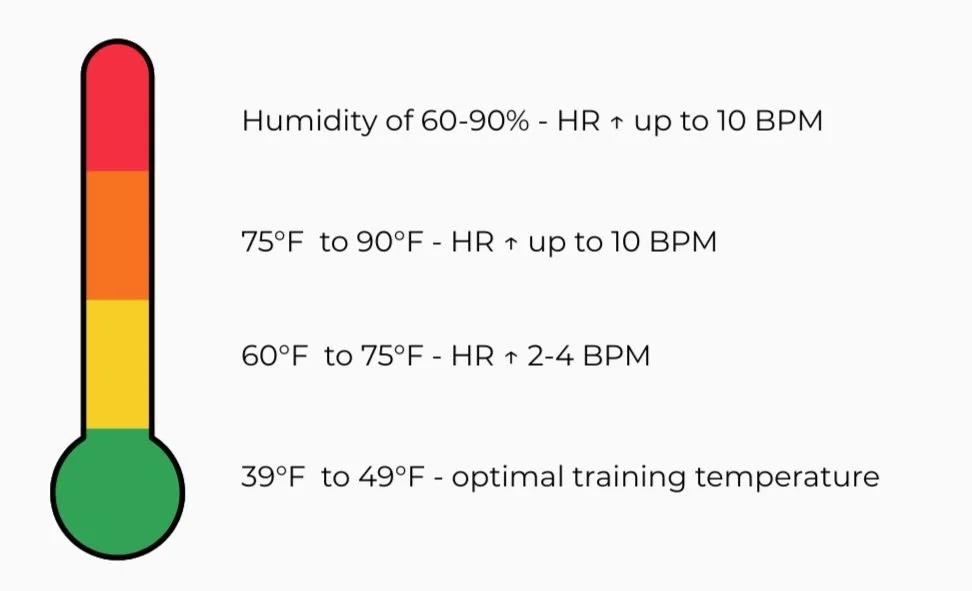Summer Training Considerations
Hot summer temperatures are officially here—and they’re not going anywhere anytime soon. But neither is your training. When heat and humidity rise, it’s common to feel like your performance is slipping. You’re not imagining it: increased heart rate, elevated sweat levels, and a harder time cooling down are all normal responses to working out in the heat.
The good news? With the right considerations, you can adapt, train smart, and stay strong all summer long. Here are a few tips we focus on with our athletes at GracesGrit to keep our athletes progress on track—even when the sun is blazing.
#1: Hydration
When training in the heat, hydration is key due to increased sweat rates.
Sweat rates can increase by 2-3x compared to cooler temperatures. Your body loses more fluid and electrolytes in the heat, making it important to replenish both after your training.
Find your summer sweat rate to create a personalized hydration plan!
Weigh yourself before exercise, making sure you are dry, without clothing, and have gone to the bathroom beforehand. Record pre-training weight.
Complete your workout and track the fluid you drink throughout.
After exercising, dry off and weigh yourself again without clothing. Record post-training weight.
Find the amount of fluid lost during exercise by subtracting your post-training weight from your pre-training weight.
Using the amount of weight lost during exercise, determine the fluid equivalent. One pound of weight loss is about 16-20 oz. of fluid lost. Consume this amount of fluid within the first hour or two after exercise.
#2: Heart Rate Changes
Your heart rate can be 10-15 BPM higher than normal when training in the heat.
An increased heart rate is a normal adaptation due to increased workload on your heart to maintain a similar pace. The higher the temperature and humidity, the greater the increase in heart rate:
Use RPE (rate of perceived exertion) in addition to heart rate zones to guide the intensity of your training.
RPE 1: No effort
RPE 2-3: Light effort
RPE 4-6: Moderate effort
RPE 7-8: Hard effort
RPE 9: Extremely hard effort
RPE 10: Maximum effort
#3: Heat Acclimation
It takes about 7-14 days of heat exposure for your body to begin acclimating to training in the heat.
Depending on the intensity, duration, and frequency of exercise, as well as number of heat exposures and environmental conditions (dry vs. humid heat), your acclimation period may vary. For some, it may take up to 2-3 weeks of constant heat exposure to fully acclimate.
Your body acclimates to the heat through:
Improved sweating
Improved skin blood flow
Improved fluid balance
Lowered body temperatures
Reduced strain on cardiovascular system
Altered metabolism
Give your body time to acclimate to the heat by slowly increasing intensity, duration, and frequency of exercise. It is normal for your paces to slow, but improvements will occur as you acclimate.
#4: Cooling Techniques
Post-training cooling strategies help to lower core temperature, speed up recovery, and reduce stress from heat.
Some helpful cooling techniques include:
Cold Drinks - Cold fluids with added electrolytes help to cool down your body and support fluid balance and carbohydrate uptake.
Frozen Hats - Stay cool during your run by wearing a frozen hat! Wet your favorite running hat and place in the freezer until it is cold and frozen.
Frozen Towels or Cooling Blankets - Grab a frozen towel or cooling blanket post-training to cool down faster. These offer convenient, on-the-go cooling recovery and effectively work to decrease your heart rate and heart rate volume. Place on areas of your body that have blood vessels close the skin, such as the neck, wrist, or forehead to maximize results.
Fruit Slushies - Try out our Watermelon Electrolyte Drink recipe for refreshing post-workout hydration!
The bottom line:
Stay consistent, stay hydrated, and listen to your body. With the right fueling strategy and a mindful approach to adapting to changes in the environment, you’ll set yourself up for strong, sustainable progress all summer long. Keep pushing forward and keep these considerations in mind when training this summer!
Learn more about all things hydration on our Hydration FAQ blog!
Have questions about how to create a personalized training or hydration plan? Contact us for an intro call—we’d love to help you out!
References:
Périard JD, Racinais S, Sawka MN. Adaptations and mechanisms of human heat acclimation: Applications for competitive athletes and sports. Scand J Med Sci Sports. 2015;25 Suppl 1:20-38. doi:10.1111/sms.12408
Nybo L, Rasmussen P, Sawka MN. Performance in the heat-physiological factors of importance for hyperthermia-induced fatigue. Compr Physiol. 2014;4(2):657-689. doi:10.1002/cphy.c130012
Wang X, Shang X, Li X, et al. Phase-change material cooling blanket: A feasible cooling choice during transport after exercise-induced hyperthermia. J Therm Biol. 2023;114:103576. doi:10.1016/j.jtherbio.2023.103576



